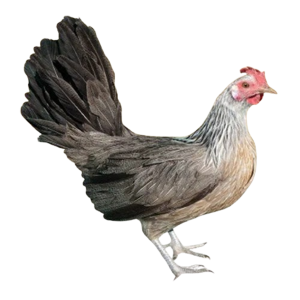ENGLISH SOMALI
Phoenix chickens are a remarkable and elegant breed known for their striking long tails and unique appearance. Originally developed in Japan and later refined in Europe, these ornamental chickens are admired for their beauty and distinctive features. Phoenix chickens are often kept for exhibitions or as decorative additions to backyard flocks, making them a favorite among poultry enthusiasts.
History and Origin
The Phoenix chicken breed originated in Japan, where long-tailed chickens, known as Onagadori, were bred for their ornamental tails. The breed was further refined in Germany by Hugo du Roi in the 19th century, creating the modern Phoenix chicken we know today. These birds are the result of crossing Onagadori chickens with other breeds to enhance their hardiness and adaptability.
Physical Characteristics
- Plumage: Sleek, shiny feathers in various colors, including Silver, Golden, Black, and White.
- Tail: Long, flowing tail feathers that can reach impressive lengths, often exceeding the body length.
- Size: Small to medium-sized birds.
- Hens: 3–4 pounds (1.4–1.8 kg)
- Roosters: 4–5 pounds (1.8–2.3 kg)
- Combs and Wattles: Single red comb and wattles.
- Legs: Slate-colored legs, clean and free of feathers.
Egg Production
Phoenix chickens are not prolific layers but can provide a modest number of eggs.
- Egg Output: 50–150 eggs annually.
- Egg Size: Small to medium.
- Egg Color: White or cream.
Meat Production
Phoenix chickens are not typically raised for meat due to their small size and ornamental value.
- Meat Characteristics: Lean and flavorful, though not abundant.
Why Choose Phoenix Chickens?
1. Ornamental Beauty
Phoenix chickens are prized for their stunning long tails and sleek feathers, making them a centerpiece in any flock or exhibition.
2. Unique Heritage
Their ties to the ancient Japanese Onagadori breed add a historical and cultural significance to owning these birds.
3. Friendly Temperament
Phoenix chickens are generally calm and friendly, making them a great choice for families and poultry enthusiasts.
4. Moderate Egg Layers
While not prolific, they can still provide a steady supply of small eggs for personal use.
Caring for Phoenix Chickens
Housing
- Provide a secure and spacious coop to protect their long tails and delicate feathers.
- Ensure perches are high enough to accommodate their tails without causing damage.
Feeding
- Feed a high-quality poultry diet supplemented with grains, greens, and protein-rich treats.
- Offer grit and calcium to support digestion and eggshell strength.
Health
- Regularly inspect their tails and plumage for cleanliness and signs of parasites.
- Protect them from extreme weather conditions, as their long feathers are susceptible to damage.
Behavior
- Phoenix chickens are active and enjoy free-ranging but adapt well to confinement if given enough space.
Uses of Phoenix Chickens
- Ornamental Purposes: Their stunning tails and elegant plumage make them ideal for exhibitions and backyard decoration.
- Egg Production: Provide a modest number of small white or cream-colored eggs.
- Cultural Significance: Their historical connection to Japan’s Onagadori breed adds value for poultry enthusiasts.
- Companionship: Friendly and calm nature makes them great pets for families.
Pros and Cons of Phoenix Chickens
Pros
- Striking appearance with long, flowing tails.
- Friendly and calm temperament.
- Moderate egg production.
- Active and adaptable to various environments.
- Unique breed with a rich history.
Cons
- Require extra care for their long tails and feathers.
- Not suitable for meat production.
- Egg production is relatively low compared to other breeds.
- Vulnerable to extreme weather and predators due to their ornamental nature.
Are Phoenix Chickens Right for You?
If you’re looking for a breed that combines beauty, history, and charm, Phoenix chickens are an excellent choice. Their ornamental value, calm demeanor, and unique heritage make them a standout addition to any backyard flock or poultry show.

